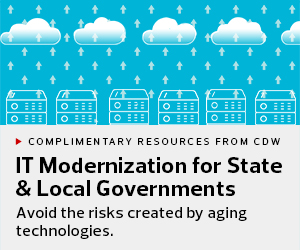Earlier this month, former Ohio CIO Ervan Rodgers stepped down from his post to become senior vice president and CIO for Designer Brands, an Ohio-based company best known for its DSW shoe stores.
From December 2018 through June of this year, Rodgers led the Office of Information Technology within the Ohio Department of Administrative Services. He provided leadership and guidance for use of IT tools and tactics to Ohio agencies, endorsing the concept of CIO as a broker. Throughout his stint as state CIO, he championed unified citizen services, which he introduced to Ohioans under an initiative called InnovateOhio.
Prior to stepping down from his post, Rodgers chatted with StateTech about the investments in infrastructure made by Ohio to achieve the seamless integration of state government services provided by InnovateOhio.
RELATED: Explore the technology and approaches needed to quickly enable digital government.
STATETECH: You’ve outlined a goal of improving the citizen experience when using government services. Can you describe how Ohio is achieving this vision?
Rodgers: Lt. Gov. Jon Husted leads our InnovateOhio initiative. We in the Office of Information Technology support him in that effort. The goal is to improve the customer experience when using government services.
We have developed an identity management solution called OHID. Each resident of Ohio has a single account to access all government services. Our goal is ultimately to enable residents to conduct all business with the government without ever having to enter a government office. So far, it’s been a great success. We cannot keep up with the demand for the service.
If you want to pay your taxes online, you can use an ID to sign into a government website. But if you want to renew your hunting license, why use a different ID? It doesn’t make sense for the citizen. Someone can go to ohio.gov and search for something related to “veterans,” which will take them to veterans services. Or, they can search for hunting licenses without knowing the Ohio Department of Natural Resources handles those licenses. You go to the right area if you type “hunting.” We want that to be as smooth an experience as possible for our citizens.
FREE RESOURCES: Get the tools you need to modernize your IT infrastructure.
STATETECH: How prepared were Ohio’s IT systems to handle the demands of the pandemic?
Rodgers: We were fortunate in that we partnered with IBM several years ago to consolidate our data center. We consolidated into a private cloud at the State of Ohio Computer Center. We began with seven agencies and expanded to all state agencies. We are working with Ohio’s 88 counties to bring them into the fold if they choose to consolidate as well.
Because of that, we were in a strong position when the pandemic hit. We could support employees working remotely. We could scale network services in response to citizen requests.
In the consolidated data center, agencies still own their data. They can manage their projects or they can acquire services through the cloud. We ask agencies to share data to improve citizen services.
STATETECH: Ransomware has been a scourge for governments for several years. How did Ohio’s pivot to remote work for state agencies during the pandemic help or hurt ransomware mitigation efforts?
Rodgers: Our remote workers really helped our cybersecurity posture. State employees received cybersecurity training, and we updated their training once everyone started working remotely. We have annual security awareness training that is updated to reflect the latest threats. We have a great chief information security officer, Russ Forsythe, who is very prepared and proactive. So, we provided cybersecurity training quickly.
As part of InnovateOhio, we have OHID Workforce, which is an identity management solution for state employees. Employees have secure access to government resources at any time. With these resources, state employees were ready to maintain a high level of cybersecurity.
STATETECH: How have you employed the cloud to enable all of the above? You’re a strong proponent of “cloud smart” implementations. What does that look like for Ohio?
Rodgers: Ohio initially adopted a cloud-first strategy, where agencies would prefer moving solutions to the cloud if possible. We have since moved to a cloud-smart strategy. We’ve embraced the “CIO as a broker” model from the National Association of State Chief Information Officers. We work with our stakeholders to evaluate the best solutions.
The state partnered with Amazon Web Services and Microsoft Azure to provide appropriate cloud services when required. We recently added Google Cloud as a partner as well. Our state computing center operates a private cloud, and agencies can deploy hybrid cloud in places where that’s the best solution. Hybrid cloud is particularly useful when agencies collect and analyze data in-house but share it with other departments.
As we are trying to innovate, we want to create an environment that gives agencies everything they need. We want to make sure we have a standard to quickly share and learn from one another. We didn’t make something custom for one agency. So, all agencies in the state of Ohio can choose those options that make the most sense for them.











